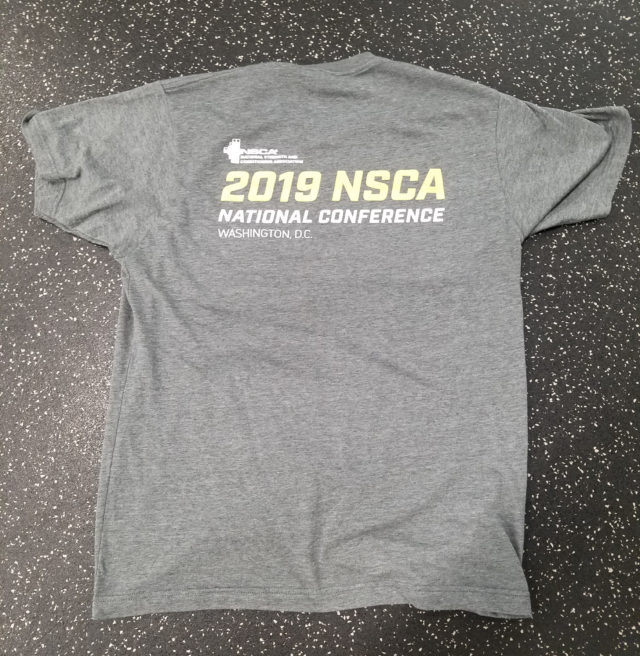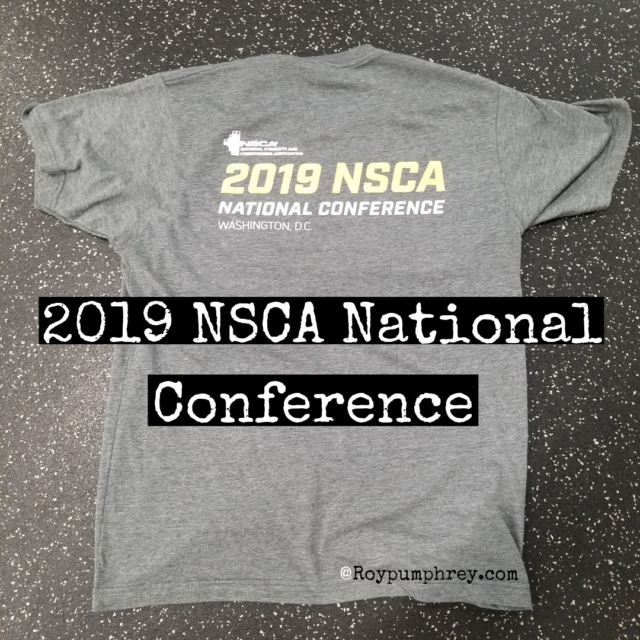
NSCA National Conference 2019 Review
After 13 years, back in the nations capital.
That means no TSA cattle calls and pat downs for this gut!
Fun story: The very 1st NSCA event I ever went to was the 2006 National Conference in Washington DC.
I wasn’t even certified, had just started working (ie I was super poor) and went for a single day (they used to have single day ticket).
Highlight was Dr. Pearson handing out string before his presentation as a prop to demonstrate why hypertrophy is important.
The string represents the muscle tissue.
As you fold the string over onto itself that’s the same as thickening of the muscle cell…ie muscle cell hypertrophy.
The low light was the LAST SESSION of the day.
At 3:50pm I walked into a conference room for a session on recovery.
At 4:20pm (yes, I was rude and left early) I walked out because, in the words of the guy filming the session,
“this is the worst one I’ve ever had to listen to”.
That was literally the worst presentation, I ever went to….EVER.
Thankfully, that’s not the case anymore and I feel like these events are getting better and better every year.
In an effort to keep this readable (limit my ramblings), we’re going to keep this review to 1-3, maybe 5 if its really necessary main points of each talk I went to.
Day 1:
Overtraining in the Weight Room? Yeah, But What’s the Big Deal? – Andrew Fry
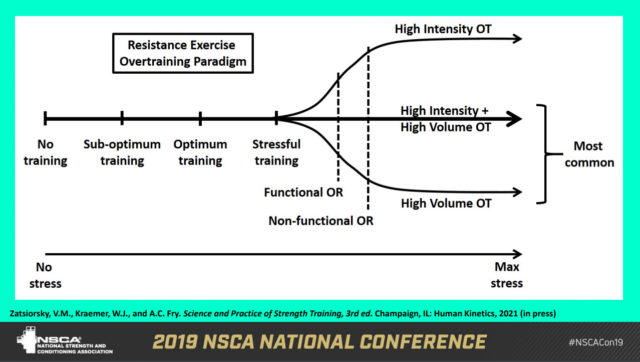
1: Overtraining is Performance Related.
If you’re training but your performance doesn’t decrease, it’s not really overtraining.
2: Damaged muscle fibers are not in a position to create force optimally.
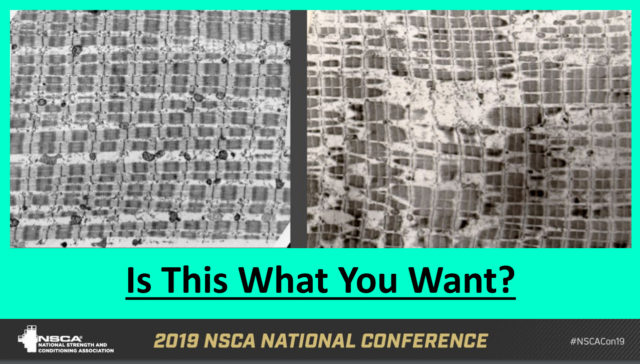 Damaged muscle fibers are on the right
Damaged muscle fibers are on the right
That said, the maximal force capabilities are not affected nearly as much as the rate of force development (RFD).
Basically, even when fatigued, you’re still strong, but you’re probably slower.
Take Home:
Better be FULLY RECOVERD at the cellular level when its competition time.
Speed Development For Team Sports- Boo Schexnayder
1: Speed is a NEURAL quality.
That means when training speed you’re training the nervous system.
This requires:
- Quality work
- Long rests between sets
- Low Volumes
Fatigue is the enemy of speed.
2: Group Your Training Stressors by Neural Demand
Basically, don’t do CrossFit random shit to get fast.
You want to send clear/ precise signals at the cellular level as to what adaptation you want.
Grouping too many different stressors in the same session pulls the cells in different neural and biochemical directions and you end up with too much “white noise”, getting no where fast.
Take Home:
Speed is trained in the ABSENCE of fatigue.
Be rested, be recovered and focus on quality work.
The Stimulus to Fatigue Ratio and it’s Select Implications- Mike Israetel
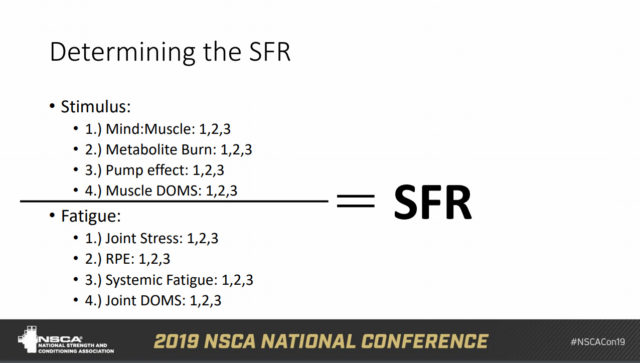
1: Find the Best Exercises For YOU
- Do you “feel” it in the right muscle?
- Does the exercise create a pump in the muscle?
- Does doing this exercise with “light” weight make you sore (not looking for soreness, but do you get mild to moderate DOMS)
- How much local fatigue does the exercise cause?
Vs
- Does this exercise create joint stress/ discomfort/ soreness in the following days?
- How much perceived effort goes into a set of this exercise?
- Performance falloff in unused muscles?
- How much falloff I the target muscle?
Essentially you can score all these categories relative to each exercise and find the ones that have the highest return for you.
Take Home:
When training for hypertrophy find the exercises, that, with the lowest load, create the highest muscular gain.
Physique Vs. Sports Nutrition: Are They Contradictory?- Shawn Arent
1: Nutrient Timing, Does it Matter?
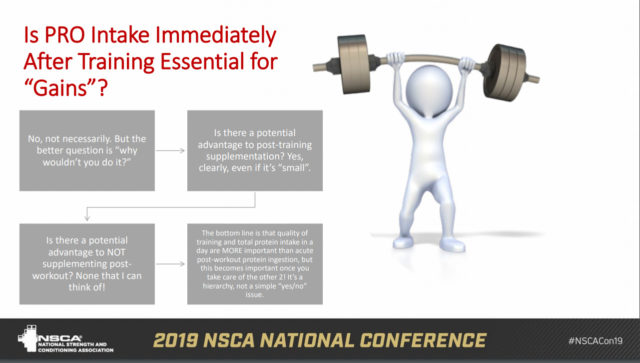
Well, while you most likely don’t need to run to the locker room to down a protein drink after training.
It probably doesn’t hurt, is most likely beneficial, even if the benefit is small and if you’re an athlete is a necessity.
2: Carbs are your Friend, Especially After Hard Training or if you Have Athletic Competitions in Short Order.
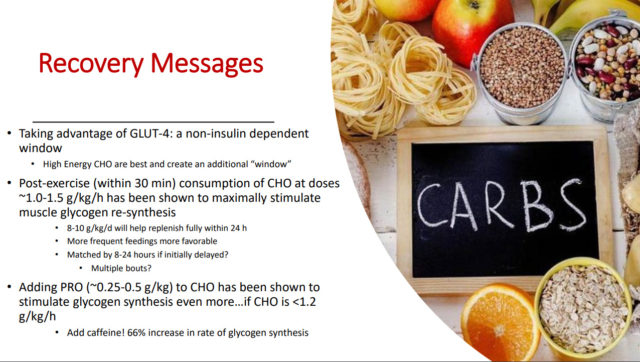
3: In the End, There are 3 Things in Sport Nutrition we Can All Agree Improve Performance.
- Protein, eat more. Its AWESOME
- Creatine is safe and it works, well, (almost) always, and it’s cheap…so buy and ingest some.
- PED’s, those work too….
But(t), just because you can, doesn’t mean you should.
Take Home:
General population nutrition and sports performance nutrition are both the same and different.
You can’t live by hard fast rules that apply to all. Nutrition needs to be individualized.
Muscle Weakness is The New Smoking- Mark Peterson
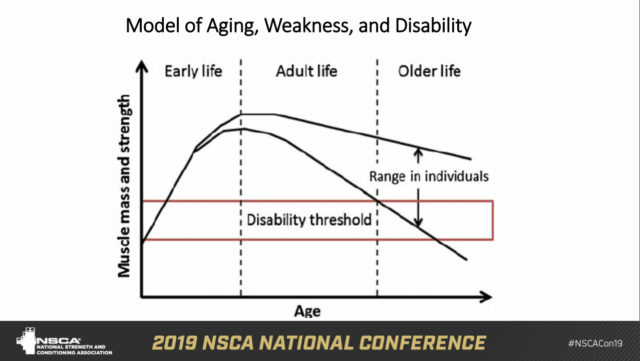
1: We’re a rapidly aging society.
- Aging usually isn’t kind to muscle mass in both quantity and quality.
2: If you Lose Enough Muscle Mass you Run the Risk of Becoming Disabled
So basically, start em young, keep em moving, build yo self some muscle and keep at it until you die.
If nothing else, you’ll die jacked and need a big casket.
Take Home:
Lift weights until the day you die.
Day 2:
Preventing Metabolic Adaptation During Weight Loss- Todd Miller and Stephanie Mull
1: Conventional Weight Loss Strategy (lots of cardio and severe calorie restriction) Sucks
- Leads to weight loss but also 20-30% loss of FFM (fat free mass)
- This leads to a reduction in the RMR (resting metabolic rate)
- The result of this is “metabolic adaptation” where the body adapts to a new lower metabolic rate.
This metabolic adaptation doesn’t need to happen if proper steps are taken.
Truth is, when lab tested, most people have a HIGHER than predicted RMR
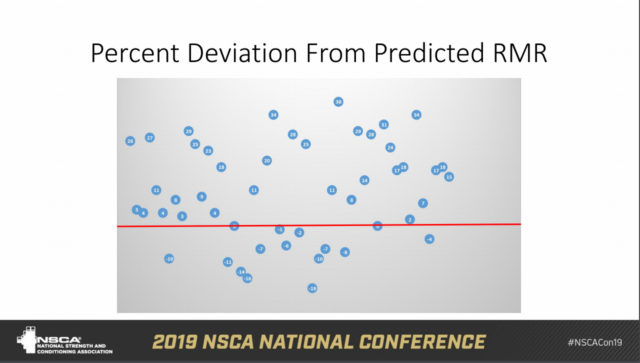
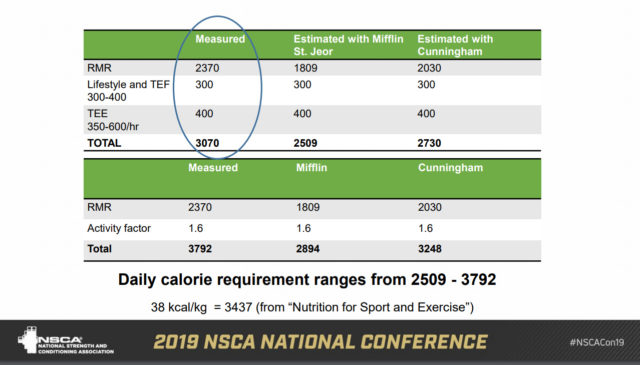
So, once again, its not your slow metabolism.
1: Eat close to your RMR (resting metabolic rate)
-
- If you can, have your RMR tested in an actual lab because the prediction equations are notoriously inaccurate.
- No more than 10% calories above RMR for males and no more than 15% calories below RMR for females.
- Track your food. Don’t guess, track.
- Take the emotions out of food and food choices.
- Look at food for exactly what it is in terms of proteins, fats and carbs.
- Just because food X. Y. or Z is considered healthy, doesn’t mean its a good choice to fit into YOUR diet.
2: Exercise is important, even though its not the driver of weight loss.
- Excessive Cardio is the EMEMY
- Weights are your BEST FRIEND.
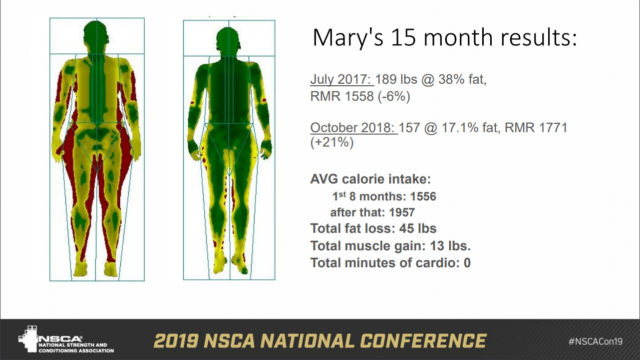 The result of 15 months of a slight calorie deficit, high protein diet, and lifting weights.
The result of 15 months of a slight calorie deficit, high protein diet, and lifting weights.
Take Home(s):
- Small caloric deficit
- Lift Weights consistently
- Protein, get you some.
High Protein Intake: Body Composition, Microbiome and Genetic Influences- Jose Antonio
1: Protein, training hard or trying to lose weight, you need more than you’re getting.
- There is still a LOT of “information” out there about the supposed dangers of “high” protein diets that is COMPLETELY UNSUPPORTED in the literature.
- In fact, when you look at the evidence, healthy, exercising, adults get BETTER outcomes in almost every category with a higher protein diet.
- Protein generally isn’t stored as fat.
- High protein diets actually lead to greater fat mass decrease vs traditional diets.
- Protein has not been to decrease bone mineral mass.
Make protein the default nutrient and fill in the rest of your calories with carbs and fats.
2: The FTO, or “Fat Gene”
- It’s an OVERCONSUMPTION gene, not a thermoregulatory gene.
- ie, it drives people to eat, it doesn’t do magical things with calories.
Re-evaluating Performance Training: Are We Enhancing Sport Performance With Strength- Josh Henkin
1: Functional Training is NOT about circus acts and stupid human tricks its about integration, timing and synergy of the neuromuscular system.
- Stability is NOT about training stabilizers, its about the sequential activation of muscles.
- Train multiplanar.
Take Home:
Repetitive movement = repetitive stress = exceeding tissue tolerance = you break
Train in all planes, to be resilient everywhere.
Revisiting The Stretch Shortening Cycle: Do We Really Know How it Works? – Jeffrey McBride
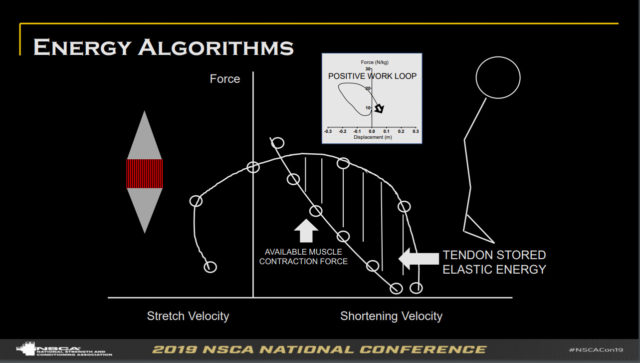 The area under the curve that’s filled in represents all of the work done by the tendons.
The area under the curve that’s filled in represents all of the work done by the tendons.
1: The muscles do very little “work” (change in length) in relation to the stretch shortening cycle. Almost all of the work happens at the tendon.
- That doesn’t mean there is no tension in the muscle.
- The MUSCLE isn’t really changing length. It’s primarily an ISO-METRIC contraction, maintaining muscle position/ stiffness
- The change in length happens almost exclusively at the TENDON during the stretch shortening cycle.
Take Home:
Once again, what we think we know, we probably don’t.
ABC’s Of Functional Exercise- Gray Cook
1: Perception CREATES movement behavior, Information reinforces movement behavior.
Before the “hardware” in the brain can change, new “software”, or perception of inputs needs to be synthesized and uploaded into the brain.
This is done by putting the person in an environment where they can experience/ lean this new software, practice it and express it through their hardware.
2: ABC
- A: Awareness
- B: Breathing
- C: Control
3: To correct movement you must become aware of that movement and what it should feel like and work towards that feeling.
- The conscious correction and strategy must become the subconscious strategy.
- Don’t be afraid of tension. Learn to move into it and breathe through it.
- Sometimes this means SLOWING DOWN the movement and focusing on your breath.
Take Home:
To change movement you need new software.
Slowing down, taking your time, controlling your breath, and using the correct new software package FOR THAT PERSON can ALL help upload new software and translate to better hardware.
Day 3:
Deceleration, Change of Direction, and Reacceleration- Jimmy Radcliffe
1: Speed in Sports Comes down to “Hip Projection” which is affected by:
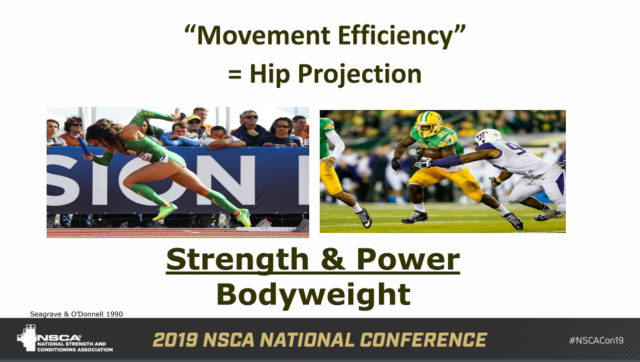
- Ground Negotiation: the ability to successfully and optimally interact the foot with the running surface.
- Postural Control: maintaining a neutral pelvis to allow for optimal torso position as well as front and back side sprinting mechanics.
2: Make sure your drills don’t look like the action you want, but actually train the action you want to take place.
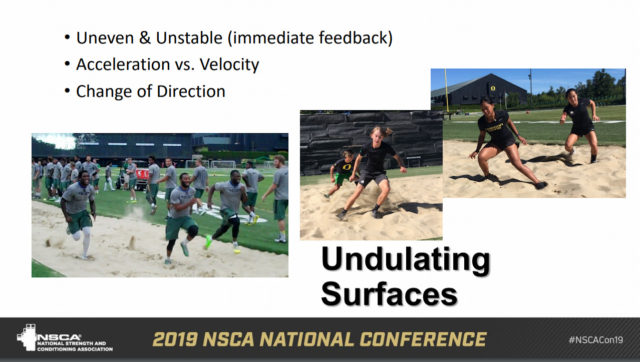
If you’ve ever heard me ramble about “stupid shit on Instagram” before, among the things I deride is sprinting and agility drills in sand.
It never made sense to me.
Doing these drills in sand kills the Stretch Shortening Cycle (plyometric effect), the thing most responsible for your sprinting/ reacceleration speed.
However, sprinting in sand forces the foot to navigate the surface and adjust instantly.
Essentially, take a crappy step or lose your posture and the increased ground contact time (amortization phase) will eat you alive.
The sand exposes your weakness.
I still think most coaches do it just because “it’s hard” and “makes the legs strong”.
But I can definitely see a rational for it now.
Take Home:
Use the correct drill, or don’t drill at all.
If you want to be fast and athletic, its ALL in the hips.
Applied Science for Exercise Programming and Injury Resilience- Andrea Hudy and Phillip Wagner
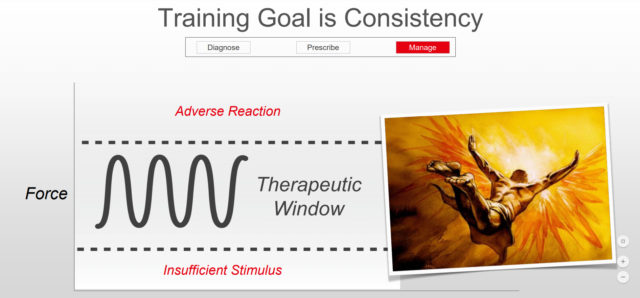
1: Exercise is Medicine.
- All athletes present with deficits in their physical qualities.
- The correct exercise applied in the correct fashion at the correct dose can rectify those deficits.
2: The goal of training is to increase the volume of work the athlete can handle at the same relative intensity, producing consistent power outputs.
- Consistent force outputs in training = consistent play outputs.
- Return to play following an injury should be based off of achieving milestones in the recovery process (merit based) not by arbitrary timeline prescriptions.
- Training should also follow a merit based progression.
- Merit based progression allows for the medicine (exercise) to take the intended physiological effect before increasing the dose or changing the medicine.
Take Home:
Athlete:
“Coach, I’m bored, when do we switch exercises?”
Dr. Wagner:
“Are the exercises still working?”
Athlete:
“Yes”
Dr. Wagner:
“Then the training stays the same. Sorry, not sorry.”
After that my brain was done and I went home.
Lots of good info, as usual, at the NSCA National Conference, 2019 edition.
This little recap doesn’t really do it justice.
Plus, as always, I got a free shirt out of the deal.
